|
|
Post by Dizzy D on May 5, 2014 5:04:30 GMT -5
As it's pretty much my area of expertise, I figured I'd start our current incarnation of this thread.
As I am terrible at finishing stuff I've started though, I'll just pick some random comics from my collection to talk about instead of trying to start a whole series from the start. (in case of multiparters, I'll try to pick the one whole story at once if possible).
For this evening I've planned to do a small bit on the Yellow Sign (to start with an actual classic that is well known and regarded) and I'll pick a random Nero comic, because Chris told me he picked up Nero in Belgium when he was here. My victim is "De A-straal" (The A-beam). More this evening when I have time and I'm trying to figure out a way to get some scans to accompany both posts.
Meanwhile I don't want to dominate this thread, so everybody else can post about what they have read or would like to read. Questions can be asked and hopefully answered.
|
|
ironchimp
Full Member
Simian Overlord
Posts: 456 
|
Post by ironchimp on May 5, 2014 5:21:17 GMT -5
I just read the first volume of Blueberry and thoroughly enjoyed it. Blueberry himself is a bit like corto maltese - slightly roguish yet a man with principles - so that makes him slightly unpredictable as to which way he will go when presented with events until you start to understand him more as a complex character. In this volume the actions of the 2nd in command at fort navajo lead to whole apache region rising in revolt after years of peace. good story, some nice art and i think it was translated into english so one should be able to find it cheap and cheerful
|
|
|
|
Post by Roquefort Raider on May 5, 2014 5:41:28 GMT -5
Great to see this thread back, Dizzy! is it okay if I re-post the stuff I had on the same subject at CBR? (Druillet, Morris, the Tintin weekly and Hugo Pratt, mostly).
|
|
|
|
Post by Dizzy D on May 5, 2014 5:44:48 GMT -5
Great to see this thread back, Dizzy! is it okay if I re-post the stuff I had on the same subject at CBR? (Druillet, Morris, the Tintin weekly and Hugo Pratt, mostly). Of course, it's okay. The more the merrier! |
|
shaxper
CCF Site Custodian
Posts: 22,871
|
Post by shaxper on May 5, 2014 5:50:25 GMT -5
So glad you're doing this, Dizzy!
|
|
|
|
Post by Nowhere Man on May 5, 2014 6:41:58 GMT -5
So far I've read the first three volumes of Blueberry (the Epic editions) and have yet to read the fourth; I snagged them all from ebay and really want to get the fifth and apparently most expensive volume soon. I did, however, snag all three volumes of The Incal recently and can't wait to dive into that. (Beyond Blueberry, I've read the first four volumes of Moebius stuff re-printed in the Epic line back in the 80's. Airtight Garage was amazing. The first time I've ever read something "dreamlike" done justice in comics.)
|
|
|
|
Post by the4thpip on May 5, 2014 6:49:27 GMT -5
Do Americans know about Lewis Trondheim yet? He's French and for a European artist incredibly productive. He's become my favorite current French comicbook writer.
|
|
|
|
Post by Roquefort Raider on May 5, 2014 7:11:19 GMT -5
(Re-posted from the original Classics Board).Thanks again to Dizzy D for reviving this thread!France and Belgium have a long tradition of excellent comics, not all of which are that well known in the Anglo-Saxon world. This tradition is built partly on a very old legacy of illustration (who hasn't been awed by the work of Gustave Doré?), but also on the very fortunate encounter between American and European sensibilities when the art of the bande dessinée was being set up in the first half of the XXth century. During WWII and the German occupation, American comic strips were obviously banned in occupied Europe. Because readers wanted to know what their heroes would be doing next, many future greats provided their own versions of Tarzan or Flash Gordon, splicing their own stories on the ones started by Hogarth and Raymond and honing their skills for what was to come later. A few years after the war, creators like Goscinny, Morris or Mézières would spend considerable time in the U.S. (Mézières was a cowboy in Utah!); meanwhile, people like Albert Uderzo would change a personal style heavily influenced by Walt Disney to one that was genuinely unique. A big difference between the Franco-Belgian comics and American ones is that the former were not distributed as a periodical pamphlet. For many decades, they were serialized in weekly journals (Coeurs Vaillants, Pif, Mickey, Tintin, Spirou, Pilote). They were also frequently not meant as pure entertainment; Coeurs Vaillants, for example, was a catholic publication and it's not surprising that the stories it featured would contain some didactic or moralistic material (and that's not necessarily a bad thing). The stories would later be collected in books, usually hardcovers, which means Franco-Belgian comics were treated as "real" books (albeit ones aimed at children) and available in regular bookstores. This granted them a certain respectability and a wider readership than if they had been confined to specialty shops. In this thread, I want to cover series that are maybe not as widely known as they deserve to be (or just some that I find cool). With the advent of new technology that makes dissemination of printed work easier, maybe they'll all be available in several languages some day. The first one is a historical series going back to 1948 : Alix. It depicts the many adventures of a young man during the last days of the Roman Republic, which serves as a very rich background and an endless source of revoltin' developments! Alix was born in Gaul, and as a small boy ended up in the eastern part of the Roman world. (Alix' father was a soldier in a Gallic corps fighting the Parthians for Rome; of his mother we know nothing). Captured and orphaned at a young age, he was a slave to the Parthians in the city of Khorsabad until the city fell to the Romans. 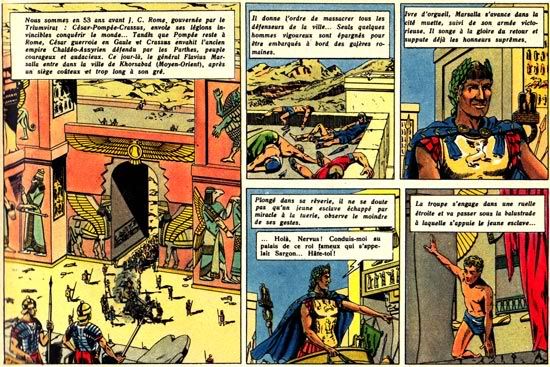 This is the first images from my 1956 copy of Alix l'intrépide, the beginning of the series. The art is still a bit stiff, very classical-looking, but we can see that much research has been invested in getting the architecture, the clothes and the uniforms right. The plot is a little like Ben-Hur (well... make that a LOT like Ben-Hur) but since the comic was published before the Charlton Heston movie, I'm sure that can be forgiven. Alix would be adopted by a respectable Roman noble in this story and so become a Roman citizen. He'd also gain the friendship and gratitude of Gaius Julius Caesar, who was getting ready for what would be the siege of Alesia (and the final conquest of Gaul). The Alix series is now more than 60 years old. Its creator, Jacques Martin, belongs to the clean line school that prevailed in the 40s and 50s and his studio formed generations of talented creators (some of whom continued the series after Martin reduced his own contribution for reasons of age). As with many such long-lived series, quality would vary depending on the period studied. The first 30 years (which is REALLY impressive!!!) deserve to be read by everyone, as they give a fun and instructive view of the Roman world circa 50 BC. Historical events are often the starting point of an adventure, even if they happened a long time before 50 BC. For example, in the story "the lost legions", reference is made to Brennus' siege of Rome in 390 BC. (That's the famous episode of the capitol geese)! 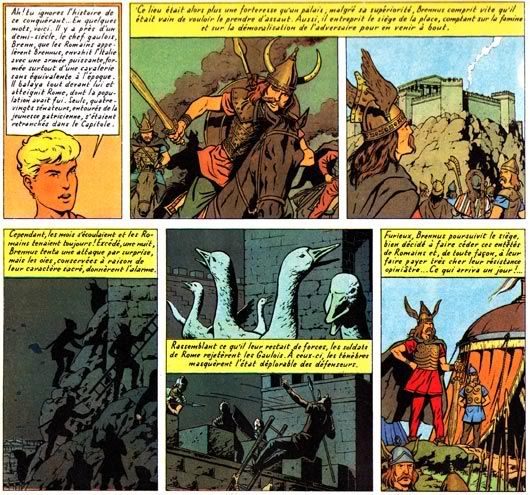 And why deny us the pleasure of a famous citation or two? 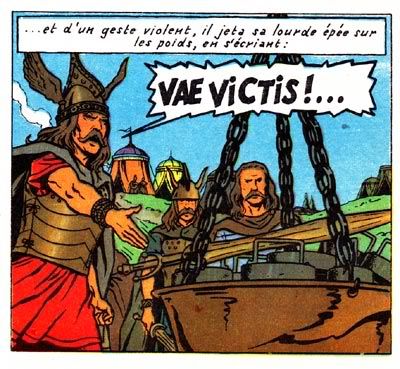
|
|
|
|
Post by Roquefort Raider on May 5, 2014 7:11:50 GMT -5
Later books (say, from the 80s to today) underwent the same process as series such as the Fantastic Four : a few attempts to re-use an old successful plot or old characters; sending the characters in places they haven't been before; resurrecting past popular villains... That's why I consider the "essential" period of Alix to have ended in the 70s. But what a period that was, stretching from the late 40s to the 70s. The art, for starters, got better and better... it really conveyed a sense of authenticity, as in this view of Rome : 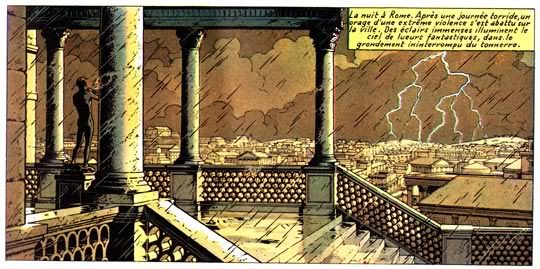 Careful research also gave rise to interesting parenthese, as in this example where a character explains the evolution of the Ammon-Moloch-Baal divinities in the near east (and segues into the siege of Carthage by its own mercenaries at the end of the first Punic war)!  |
|
|
|
Post by Roquefort Raider on May 5, 2014 7:13:21 GMT -5
Classic scenes from literature were also frequently depicted. The fall of Alesia and the surrender of Vercingetorix in the second graphic novel; the terrible scene of the Carthaginians immolating their own children to their god Moloch-Baal (also seen in Gustave Faubert's novel Salammbo). 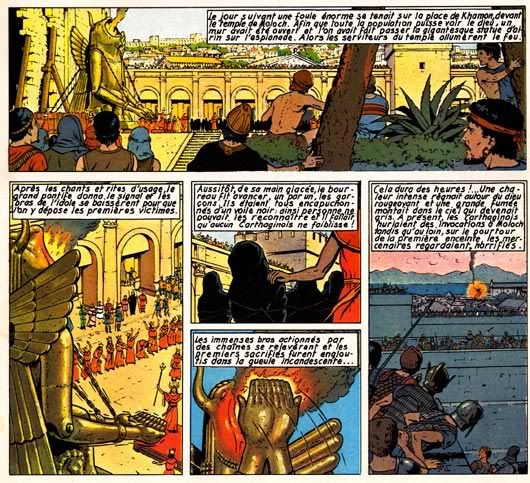 The series reached truly epic levels from time to time, as in the book "The last Spartan" (that's more a graphic opera than a graphic novel)! Here we learn that after the fall of Greece to the Romans, a fortified city of Spartans continued living in secrecy, preserving their independence, and sometimes capturing shipwrecked travelers to use as slaves. 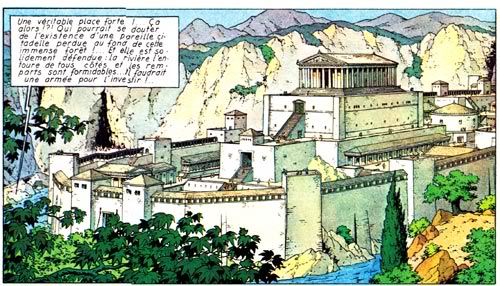 To save his young ward, Alix will infiltrate the city but end up captured. His relation with the city's queen will be ambiguous and tragic. She respects his courage and honesty and wishes him to act as her son's teacher; at the same time, she fears him because in a dream she saw he would doom her city. (At the same time, she suspects he may be the only one who can save her son should her dream proves true). 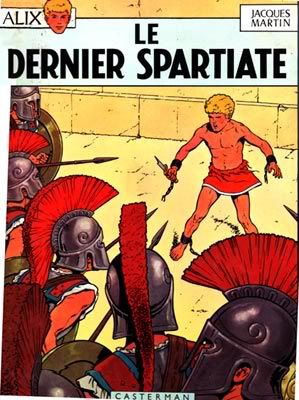 Alix is torn between his word to the queen and his responsibility to his ward and the other slaves of the city (most of them Roman citizens). When escaped slaves manage to bring back a Roman army to besiege the city, the slaves are marked for death and the die is cast; Alix leads a revolt. 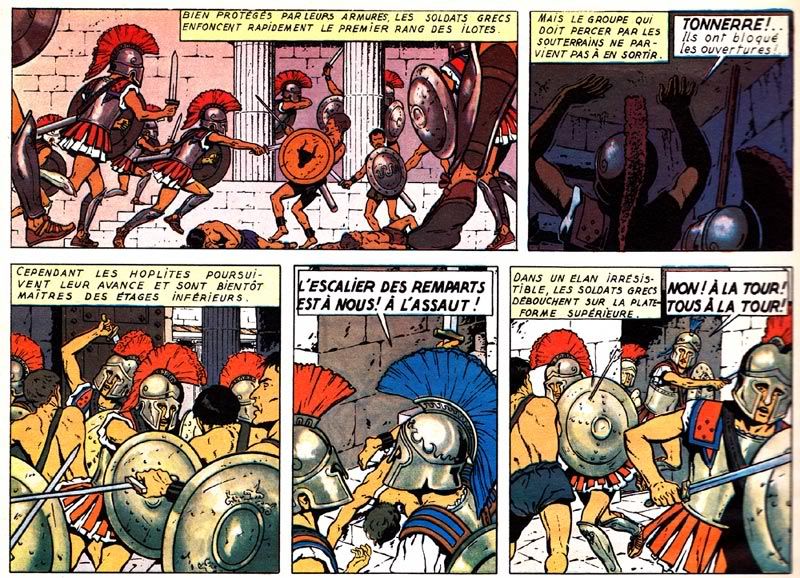 The Spartans are no match for the invading army, but rather than be defeated, the queen and her guard prefer to perish with their city -after the queen asks Alix to see after her son. This is drama with a capital D, here. Wagnerian stuff. 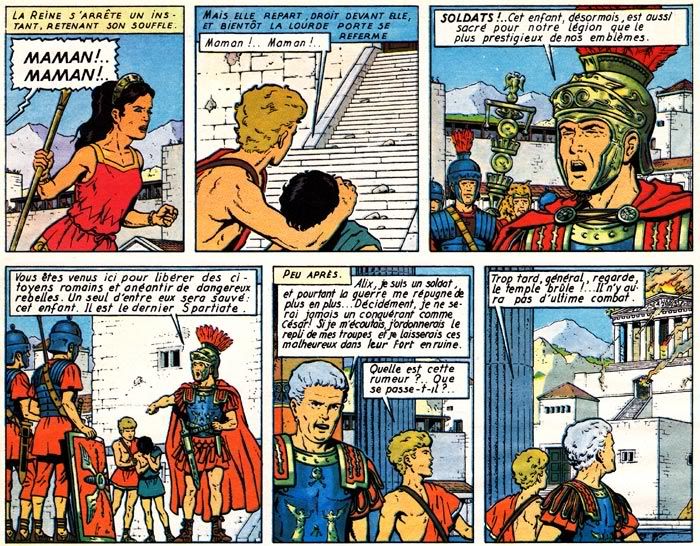 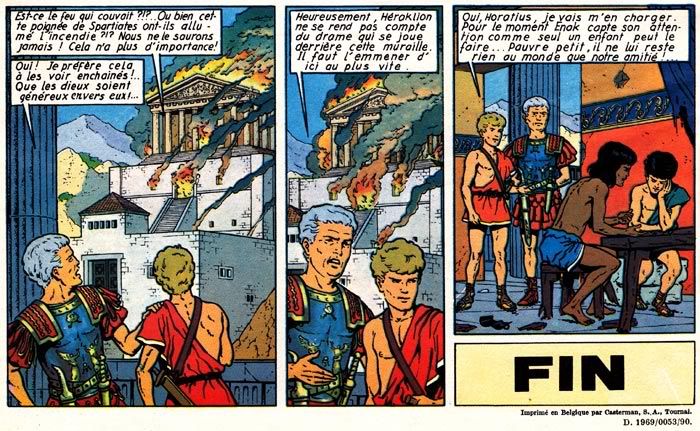 The series was adapted as a TV cartoon, with fairly faithful adaptations. I'm afraid however that there's no way a typical TV animation can do justice to Martin's lush and expansive decors. A great series, well worth reading. |
|
|
|
Post by Roquefort Raider on May 5, 2014 7:16:15 GMT -5
Maybe I would have been better advised to conclude "well worth translating" rather than "reading" (the point of this thread being series that aren't readily available in the English-speaking word)! The ever helpful Wikipedia tells us the following regarding English translations, and it's not encouraging: ![]() Originally Posted by WikipediaAlix has seen little translation into English. In 1971 the London publisher Ward Lock & Co issued two titles, The Sacred Helmet (La tiare d'Oribal), and The Black Claw (La griffe noire). These books are now considered relatively rare. Two more titles, The Lost Legions (Les légions perdues), and The Altar of Fire (Le dernier Spartiate) were also projected for publication that year, but never appeared. A reviewer for the Times Literary Supplement found Alix singularly lacking in humour compared to Asterix, effectively killing prospects for continued publication in a market not yet accustomed to the wider Franco-Belgian tradition.Sadly, I've seen more Alix books in latin than in English. An important difference between this series and the Classics Illustrated is that the latter often had an awful lot of expository text, paralleling the images but not being really integrated. They had the distinct feel of a product assembled with one goal in sight : make classic texts more readily available to a young public, not tell a great comic-book story. The stiffness of the ligne claire style, I believe, is not a bug but a feature; it's typical of the "realistic" strips of that period (as opposed to the humor strips, where exaggerated anatomy, movement lines and a greater suppleness of the brush were allowed). A Roman in Asterix will not look like a Roman in Alix! That being said, what it loses in dynamism, this style will compensate for in realism. These Romans I could take seriously! ![]() The same holds true for strips like Blake & Mortimer, where even the most outlandish scripts were somehow made more believable by a subdued and restrained artwork. |
|
|
|
Post by Roquefort Raider on May 5, 2014 7:20:47 GMT -5
Lucky LukeThe comic-book world has its famous creators, and then it has its gods... the creators who were so amazingly good that they changed the way comics were made for one or more generations. The kind of people who eventually have a prize named after them. In the US, they are the Kirbys, the Eisners, the Fosters... One such creator in France was René Goscinny, who among other things was the co-creator of Asterix with artist Albert Uderzo. Goscinny was a very, very funny man. A very cultivated one too, but not one to flaunt his culture as an esthete snob; he was one to revel in the sheer fun of it. Hence the brilliance of Asterix, which can be read at many levels and be as much fun for adults as it is for kids. Goscinny was the driving force behind the journal Pilote, where strips such as Lt. Blueberry and Valérian would push the limit of what a comic-strip was supposed to be like. While he did not create Lucky Luke, he certainly hepled make it the sucess it is still today. Lucky Luke was created by Maurice de Bevère, better known as Morris, in 1946. Morris was a big fan of American animation, which is obvious in his early art. He lived for a while in the US where he met Harvey Kurtzmann, and was there when MAD was born. 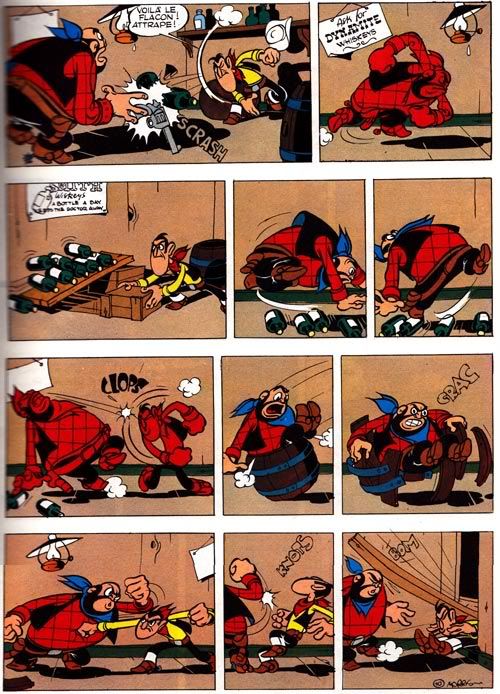 The early adventures of Lucky Luke, "the man who shoots faster than his own shadow", were aimed at a very young audience. The very first were very much in the tradition of Popeye or Disney, with a dynamic visual humor and simple backgrounds. The series would take a brief detour in a more serious direction for a few books, but returned to humor with the arrival of Goscinny in 1955. And a damn funny book it became, in the Asterix tradition (only in the old west). The premise is simple: Lucky Luke is a poor lonesome cowboy, and he travels the west catching crooks and highwaymen and basically exploring western folklore. He would meet such characters as Jesse James, Billy the kid, Black Bart, emperor Smith, judge Roy Bean... and of course his recurrent nemese, the Daltons. He would be there for the Oklahoma rush, for the discovery of oil in Texas, for the race between the two railroad companies that tried to cross the country... Lots of history to cover in those old U.S. of A.!
|
|
|
|
Post by Roquefort Raider on May 5, 2014 7:23:26 GMT -5
He also had a keen sense of the absurd. In this scene from "Along the Mississippi", a paddleboat has lost its way because the river has gone over its banks. An irate farmer warns the boat to get off his property, and threatens to sic his dog on them if they don't comply! When the boat's pilot asks the way to Cairo, he's told to follow the railroad. 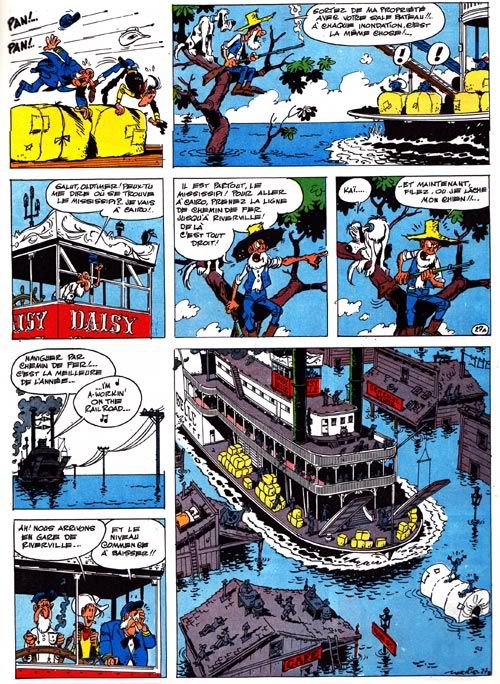 Here's another example: Apaches tie Luke on the ground and cover him in honey, the better to summon red ants that will devour him. A little boy is quite against this waste of honey, as can be seen on the page. 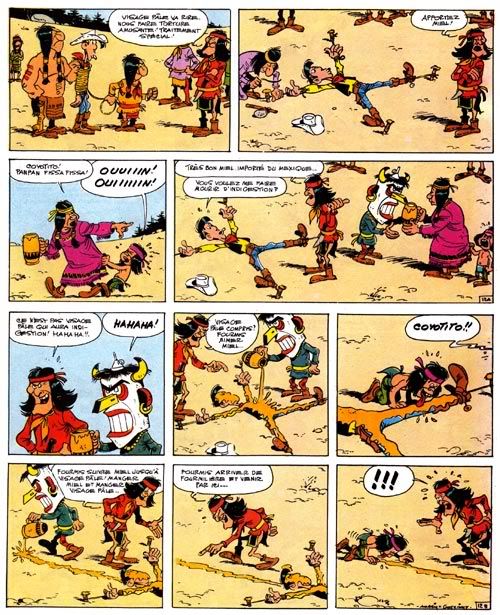 When told he won't get to be a warrior if he keeps this up, the little boy angrily claims that he wants to be an ant when he grows up. People in white coats (science cartoons, updated daily) | Art BlogThe success of the series owe a lot to the outrageous supporting cast. Luke's horse Jolly Jumper always has a quip suited to the situation. The penitentiary's staff (from which the Daltons escape every other week) are remarkably daft. And what to say of Ran Tan Plan, the penitentiary's dog, and the world's most stupid canine? This bizarro Rin Tin Tin got to be so popular that he ha enjoyed his spin-off series for decades now. 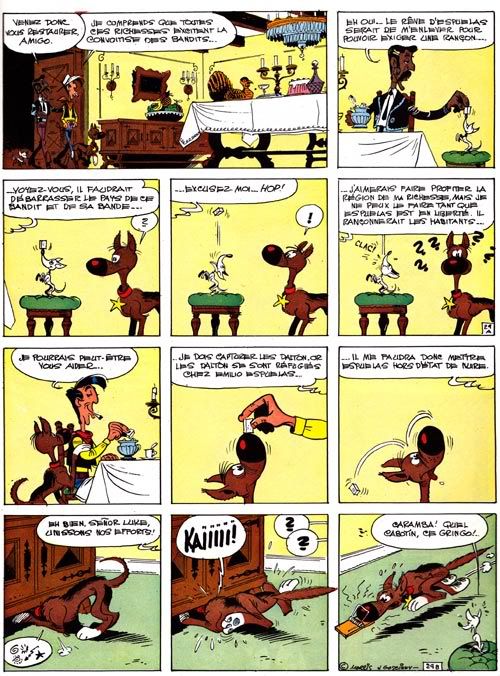 |
|
|
|
Post by Roquefort Raider on May 5, 2014 7:25:47 GMT -5
The Daltons are Lucky Luke's perennial opponents. Well, opponents... they are such incompetent criminals that they never manage to do anything too threatening. But when they escape from jail, they have to be caught and brought back! In the image below, Averell Dalton is told by his brother to stop cleaning his ear with his six-shooter because it's really bad manners. 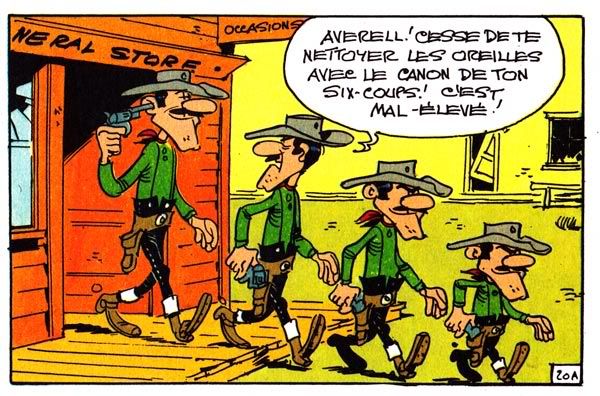 And one thing this comic-book series has certainly done in France is to get everyone to know this particular song, as it concludes every story! 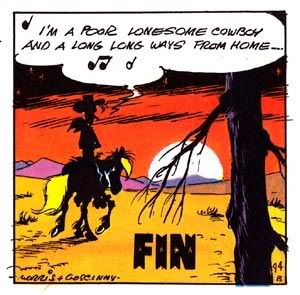 |
|
|
|
Post by DubipR on May 5, 2014 9:15:28 GMT -5
Do Americans know about Lewis Trondheim yet? He's French and for a European artist incredibly productive. He's become my favorite current French comicbook writer. At least this American knows Lewis Trondheim. I love Dungeon.
I first knew of his work from getting all the NBM Publishing catalogs. One of my favorite comics he did was for MEASLES for Fantagraphics (a pick of mine from 2012's Classic Comics of Christmas). He's a fantastic creative force.
|
|